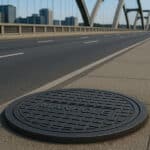Manhole covers are essential to modern infrastructure, providing access to underground utilities while ensuring public safety. The selection of a manhole cover must adhere to certain standards and technical requirements to ensure performance, safety, and durability. This article will explore these standards, the materials commonly used, load-bearing classifications, environmental considerations, and more. This comprehensive guide is aimed at helping procurement professionals make informed decisions when purchasing manhole covers for various applications.
The Importance of Standards in Manhole Cover Design
Overview of Standards
Adhering to established standards ensures that manhole covers meet safety, performance, and durability requirements. These standards are typically set by industry bodies, government organizations, and engineering associations, including ISO (International Organization for Standardization) and EN (European Norm) standards.
The primary purpose of these standards is to provide uniformity in the manufacturing, testing, and installation of manhole covers, ensuring they are suitable for different environmental conditions and load-bearing applications. This is especially crucial for infrastructure projects that require long-term performance and safety assurances.
Why Compliance Matters
Non-compliance with established standards can lead to safety hazards such as cover breakages, misalignments, or inadequate load-bearing capacity, which can cause accidents or damage to vehicles and pedestrians. For procurement professionals, selecting manhole covers that meet these standards is a critical step in minimizing liability and ensuring the longevity of public infrastructure.
Material Standards and Requirements
Cast Iron and Ductile Iron
The most common materials used for manhole covers are cast iron and ductile iron due to their strength and durability. Standards such as EN 124 classify covers based on their material and application. Cast iron covers are generally used in heavy traffic areas because of their load-bearing capabilities. Ductile iron, on the other hand, provides higher strength and flexibility compared to cast iron, making it suitable for high-stress environments.
- Cast Iron: Known for its rigidity and weight, cast iron is typically used in urban settings with moderate to heavy traffic. However, it is prone to corrosion, so it must be treated with anti-corrosion coatings.
- Ductile Iron: This material offers greater durability and resistance to wear, making it ideal for industrial applications. Ductile iron can handle fluctuating loads and is less prone to cracking under stress.
Composite Materials
Composite materials are becoming increasingly popular for manhole covers, particularly in areas requiring lightweight, corrosion-resistant, and non-metallic solutions. Composites are typically made from a mixture of fiberglass and resins, making them highly durable while also reducing the risk of theft.
- Corrosion Resistance: Composite manhole covers are often used in coastal areas or chemical environments due to their high resistance to corrosion.
- Lightweight Design: The lightweight nature of composite covers makes them easier to install and remove, reducing labor costs for maintenance.
Load Capacity Classifications
EN 124 Load Classes
Manhole covers are classified based on their load-bearing capacity, which determines where they can be installed. The EN 124 standard outlines six primary load classes:
- Class A15: Suitable for pedestrian areas and zones with no vehicular traffic (15 kN load capacity).
- Class B125: Used in car parks, sidewalks, and residential driveways with occasional traffic (125 kN load capacity).
- Class C250: Suitable for curbside areas, where light vehicles may pass (250 kN load capacity).
- Class D400: Designed for roadways and heavy traffic areas (400 kN load capacity).
- Class E600: For heavy-duty applications such as industrial zones and docks (600 kN load capacity).
- Class F900: Typically used in airports and loading docks, this class is for extreme load requirements (900 kN load capacity).
Choosing the Right Load Class
Selecting the appropriate load class is essential to ensure safety and avoid damage to the infrastructure. For example, using a Class B125 cover in a heavy traffic area could result in premature failure, whereas a Class D400 cover would be more appropriate for roadways.
Environmental and Safety Considerations
Corrosion and Weather Resistance
Manhole covers exposed to harsh environments, such as coastal areas or chemical plants, require materials with high corrosion resistance. Cast iron covers need protective coatings to prevent rust, while composite materials naturally resist corrosion without additional treatment.
Anti-Slip Surface
Safety standards often require manhole covers to have an anti-slip surface, especially in pedestrian areas or zones where wet conditions are common. Textured surfaces or the addition of grip-enhancing materials can prevent slips and falls.
Noise Reduction
In urban environments, manhole covers can generate noise when vehicles drive over them. To address this, many covers are designed with rubber seals or noise-dampening features to reduce the impact noise, which is crucial for residential areas or sensitive environments like hospitals.
d. Fire Resistance
In certain applications, such as oil refineries or chemical plants, manhole covers must meet fire resistance standards. Composite covers offer a degree of fire resistance, but additional treatments may be required for covers in high-risk areas.
Manhole Cover Design and Manufacturing Requirements
Design Specifications
Manhole cover design must accommodate both functional and aesthetic needs. Covers can be circular, rectangular, or square, depending on the specific installation requirements. Circular covers are preferred for roadway applications because they are less likely to fall into the manhole, while square or rectangular covers may be more suitable for utility access areas.
- Lifting Mechanisms: Covers designed for frequent access may include built-in lifting mechanisms, such as handles or keyholes, to facilitate easy removal and replacement.
- Logo and Branding: Some manufacturers offer customized covers with logos or branding elements for municipalities or businesses.
Manufacturing Processes
Manufacturing manhole covers involves casting or molding the material to the required shape and specifications. Key manufacturing methods include:
- Sand Casting: Commonly used for iron covers, sand casting involves pouring molten metal into a sand mold. This process is cost-effective but may result in a rougher surface finish.
- Compression Molding: Used for composite covers, this process ensures a smoother finish and precise dimensions, ideal for customized designs.
Quality Control
All manhole covers must undergo stringent quality control measures to ensure they meet the specified load-bearing capacities and safety standards. Quality control processes typically include:
- Load Testing: Covers are subjected to pressure tests to ensure they can handle the designated load capacity.
- Impact Testing: To simulate real-world conditions, covers are tested for impact resistance to ensure they do not crack or deform under stress.
- Corrosion Resistance Testing: Especially for cast iron covers, this ensures that protective coatings are effective in preventing rust and other forms of degradation.
Procurement and Cost Considerations
Factors Affecting Pricing
Manhole cover prices vary depending on the material, load class, and customization options. Cast iron covers tend to be more expensive due to their material cost and manufacturing process, while composite covers, although initially costly, may offer long-term savings due to their durability and reduced maintenance needs.
- Material Costs: The price of raw materials such as iron, steel, or composite polymers will significantly impact the final cost.
- Customization: Adding features like logos, anti-slip surfaces, or noise-dampening components will increase the price.
Total Cost of Ownership
When purchasing manhole covers, it’s important to consider the total cost of ownership (TCO), which includes not only the initial purchase price but also installation, maintenance, and replacement costs. Composite covers, for example, have a higher upfront cost but require less maintenance, making them more cost-effective in the long run.
Conclusion
Selecting the right manhole cover involves understanding the standards and technical requirements that govern their design, manufacture, and performance. From choosing the appropriate material and load class to considering environmental factors and quality control measures, procurement professionals must take a comprehensive approach to ensure that the covers they select meet both safety and operational requirements. By adhering to established standards and carefully evaluating the options available, buyers can make informed decisions that ensure the longevity and functionality of their infrastructure.





